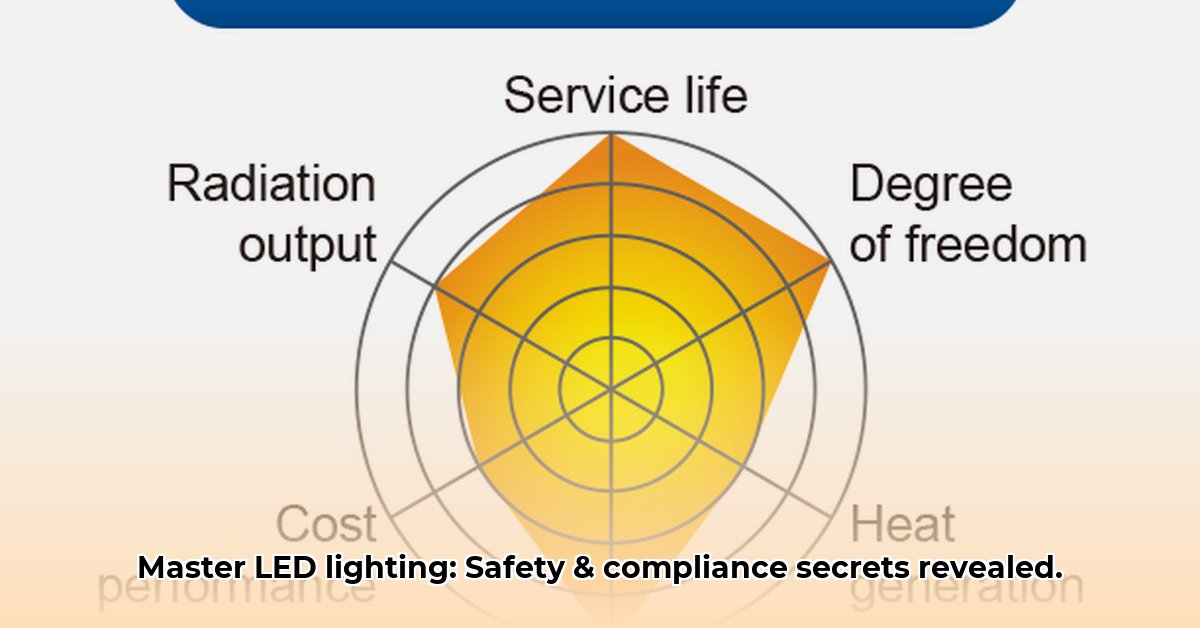
Designing effective and safe LED lighting systems requires more than just selecting the right bulbs. It demands a meticulous process, strict adherence to regulations, and a blend of technical expertise and creative vision. This comprehensive guide illuminates the path to a successful LED lighting project, catering to both novice enthusiasts and experienced designers. For more information on lighting basics, check out this helpful resource on lighting design.
Understanding the Importance of Standards: A Foundation for Success
Before diving into the specifics of design, understanding the "why" behind compliance is paramount. Adherence to safety and performance standards is not merely a suggestion; it's a cornerstone of responsible LED lighting design, ensuring longevity, functionality, and most importantly, safety. Ignoring these crucial standards can result in malfunctions, hazards, and potential legal ramifications.
UL Standards (Underwriters Laboratories): In the United States, UL certification signifies a thorough safety evaluation, offering a reassurance of compliance and reduced risk. It's a mark of approval guaranteeing that the product meets rigorous safety standards.
IEC Standards (International Electrotechnical Commission): IEC standards are globally recognized, establishing guidelines for electrical safety and performance across various components, including LED lighting. They represent a comprehensive international framework for electrical safety and interoperability.
Local Building Codes: Always consult local building codes and regulations, as these often introduce region-specific requirements for wiring, fixture types, and installation procedures. These local amendments are equally critical for ensuring compliance.
These standards are not optional; they are the foundation upon which a dependable and safe LED lighting installation is built. Cutting corners compromises safety and increases the risk of future problems.
Choosing the Right Components: The Heart of Your Project
Selecting appropriate components is pivotal for the success of your LED lighting project. The choices you make here directly impact the system's performance, lifespan, and safety.
LED Drivers: These are the power supply for your LEDs, converting main voltage to the appropriate level for optimal LED operation. It's critical to select drivers compatible with your specific LEDs and wattage, ensuring they meet safety standards. A faulty driver can compromise the entire lighting system.
Heat Sinks: LEDs generate heat; effective heat dissipation is essential for longevity and peak performance. Inadequate cooling can lead to premature LED failure. Invest in correctly sized heat sinks to maintain safe operating temperatures.
Wiring and Cabling: Employ high-quality wiring and cabling that meet relevant safety standards. Compromising on wire quality is a frequent cause of premature LED system failures and potential safety hazards.
Protection Devices: Circuit breakers, surge protectors, and other safety devices are crucial for protecting the system from overloads, surges, and other electrical hazards. These preventative measures, while representing a small upfront cost, offer significant protection against costly repairs or worse.
A Step-by-Step Design Process: From Conception to Completion
A well-structured design process is crucial for success, ensuring a cohesive and functional LED lighting system. Here's a step-by-step approach:
Needs Assessment: Precisely define your lighting goals. What areas need illumination? What ambiance is desired? Will the lighting primarily serve a functional or aesthetic purpose?
Light Calculations: Determine the number and type of LEDs required. Software tools and online calculators can assist with these calculations. Accurate calculations ensure sufficient illumination without wastage.
Fixture Selection: Choose fixtures that meet your needs and aesthetic preferences. Consider factors such as color temperature, light distribution, and energy efficiency.
Layout & Wiring Diagram: Create a detailed schematic illustrating fixture placement and wiring. This plan is essential for installation and troubleshooting. A clear diagram prevents mistakes during installation.
Installation: Strictly adhere to local codes and regulations during installation. Pay close attention to wiring and connections to avoid electrical hazards. Consult a professional electrician for tasks outside your expertise.
Testing & Commissioning: Thoroughly test the system to verify all components function as intended. This final check helps to identify and rectify any issues before they escalate.
Managing Risks: A Proactive Approach to Safety
Every project involves inherent risks. Proactive mitigation strategies are key to minimizing potential issues:
| Risk Factor | Mitigation Strategy |
|---|---|
| Overheating | Utilize appropriate heat sinks and ensure adequate ventilation. |
| Electrical Hazards | Correct wiring, proper grounding, and use of protection devices. |
| Component Failure | Choose high-quality, certified components from reputable manufacturers. |
| Non-Compliance with Codes | Thoroughly review and adhere to all relevant regulations. |
Diligent implementation of these strategies significantly reduces the probability of problems.
Advanced Techniques for Enhanced Designs: Elevating Your Projects
Experienced designers utilize these advanced techniques to optimize their projects:
Lighting Simulations: Software tools allow for accurate prediction of lighting performance, enabling adjustments before installation, saving time and resources.
Energy Efficiency Strategies: Incorporate dimming controls, occupancy sensors, and daylight harvesting to maximize energy efficiency and minimize operational costs.
By following this guide and incorporating advanced techniques, you can create safe, efficient, and visually appealing LED lighting systems that meet all necessary compliance standards. Remember: Prioritize safety and compliance throughout the design and installation process.